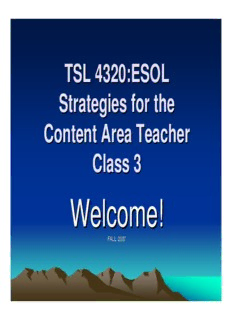
(Different aspects of language and theories of second language acquisition...) TSL4320_PPT2 PDF
Preview (Different aspects of language and theories of second language acquisition...) TSL4320_PPT2
TTSSLL 44332200::EESSOOLL SSttrraatteeggiieess ffoorr tthhee CCoonntteenntt AArreeaa TTeeaacchheerr CCllaassss 33 Welcome! Welcome! FFAALLLL 22000077 AAggeennddaa • Welcome! Qs & As • Sharing—Modified vs. Non-Modified Lesson Findings (turn in Venn Diagram) • ESOL Program Models • Language Learning: Language Structures, Dialects • Book Buddy Discussion • Sharing L2 Learning Experiences • Comparing L1/L2 Learning • Second Language Acquisition – Theories – Stages – Affecting Factors SShhaarriinngg——MMooddiiffiieedd vvss.. NNoonn--MMooddiiffiieedd LLeessssoonn GGrroouupp VVeennnn ddiiaaggrraamm PPrrooggrraamm MMooddeellss aanndd CCaassee SSttuuddiieess Complete the blanks on the chart provided ESOL Models 1. Mainstream Classes (inclusion) 2. Self-contained Classes (elementary) and Sheltered Classes (high school)* 3. ESOL Pullout Bilingual Models 1. Two-way Bilingual Programs 2. Transitional Bilingual Programs 3. Maintenance Programs LLaanngguuaaggee AAccqquuiissiittiioonn,, SSttrruuccttuurree,, && UUssee ““EEvveerryy tteeaacchheerr iiss aa llaanngguuaaggee tteeaacchheerr..”” LLAANNGGUUAAGGEE AACCQQUUIISSIITTIIOONN---- HHmmmmmm…… 1. Is learning your native language more like learning to walk or like learning to play a musical instrument? Why? 2. Is language innate or learned—or both? Explain. 3. What kinds of (corrective) feedback do parents give to children learning language? MMoorree ppoonnddeerriinnggss…… (cid:134) Do primitive languages exist? (cid:134) What are language universals? (cid:134) How does language change? (cid:134) How do children learn their first language? LLAANNGGUUAAGGEE AACCQQUUIISSIITTIIOONN,, SSTTRRUUCCTTUURREE,, AANNDD UUSSEE • All processes acquired simultaneously • Acquisition, structure, and use informed by culturally accepted values and beliefs • Assumptions and perceptions made about ‘mismatches’ or ‘mistakes’ – Language learning occurs naturally – Language is complex – Implications for re-thinking how we organize language learning & development in US public schools SSttrruuccttuurree ooff LLaanngguuaaggee PPrriimmeerr • Phonology • Syntax – Grammar – Morphology • Semantics • Pragmatics • Discourse • Nonverbal communication • Language variation: dialects PPhhoonnoollooggyy:: TThhee SSoouunndd SSyysstteemm ooff aa LLaanngguuaaggee • Languages have different sounds – “rr” in Spanish – “th” in English – Other examples? • Languages allow only certain sound combinations (phonemic sequences) – “special” (Eng.) v. “especial” (Span.) – “Ngo” (Viet.) v. “singing” (Eng.) – Other examples?
Description: